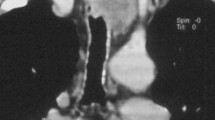Abstract
Purpose
Patients with laryngeal cancer may necessitate tracheostomy placement to alleviate compromised airways. However, the impact of tracheostomy on thyroid gland invasion and its implications for prognosis in individuals who further undergo total laryngectomy remains unclear. This study aimed to assess thyroid gland invasion rates and explore the 5-years disease-free and overall survival in laryngectomized patients stratified by preoperative tracheostomy.
Methods
All patients who underwent total laryngectomy for laryngeal cancer between 2003 and 2023 at a tertiary referral center were retrospectively reviewed. Logistic univariable and multivariable regressions were performed to identify factors associated with thyroid gland invasion. Survival analyses were performed using the Kaplan–Meier estimator.
Results
A total of 119 laryngectomized patients were included (mean age: 63 ± 10 years, range 35–89, 110 [92.4%] males); 27 (22.7%) underwent preoperative tracheostomy. In 16 (13.4%) patients, tumor cells were found within the thyroid gland. In a multivariable analysis, thyroid gland invasion was independently associated with preoperative tracheostomy (odds ratio [OR] 3.13, 95% confidence interval [CI] 2.45–6.19), pN2 + (OR 2.13, 95% CI 1.8–5.14), positive margins (OR 1.36, 95% CI 1.01–1.77), lower 5-year disease-free survival (38% vs. 57%, p = 0.01), and lower 5-year overall survival (40% vs. 56%, p = 0.03).
Conclusion
Preoperative tracheostomy is an independent predictive factor for thyroid gland invasion and has adverse oncological outcomes in laryngectomized patients. Conversely, the rates of thyroid gland invasion are low when tracheostomy was not performed beforehand.




Similar content being viewed by others
Data availability
Generated/analyzed data in this study will be made available to researchers upon reasonable request to the corresponding author.
References
Siegel RL, Miller KD, Fuchs HE, Jemal A (2022) Cancer statistics, 2022. CA Cancer J Clin 72(1):7–33. https://doi.org/10.3322/caac.21708. (Epub 2022 Jan 12)
Forastiere AA, Goepfert H, Maor M et al (2003) Concurrent chemotherapy and radiotherapy for organ preservation in advanced laryngeal cancer. N Engl J Med 349(22):2091–2098. https://doi.org/10.1056/NEJMoa031317
The NCCN Clinical Practice Guidelines in Oncology (NCCN Guidelines®) for Head and Neck Cancers version 1.2023. https://www.nccn.org/guidelines/guidelines-detail?category=1&id=1437. Accessed on May 26th, 2023.
Basheeth N, O’Leary G, Khan H, Sheahan P (2015) Oncologic outcomes of total laryngectomy: impact of margins and preoperative tracheostomy. Head Neck 37(6):862–869. https://doi.org/10.1002/hed.23681. (Epub 2014 Jun 27)
Birkeland AC, Rosko AJ, Beesley L et al (2017) Preoperative tracheostomy is associated with poor disease-free survival in recurrent laryngeal cancer. Otolaryngol Head Neck Surg 157(3):432–438. https://doi.org/10.1177/0194599817709236. (Epub 2017 Jun 6)
Pezier TF, Nixon IJ, Joshi A et al (2013) Pre-operative tracheostomy does not impact on stomal recurrence and overall survival in patients undergoing primary laryngectomy. Eur Arch Otorhinolaryngol 270(5):1729–1735. https://doi.org/10.1007/s00405-012-2213-2. (Epub 2012 Oct 9)
Nayak SP, Singh V, Dam A et al (2013) Mechanism of thyroid gland invasion in laryngeal cancer and indications for thyroidectomy. Indian J Otolaryngol Head Neck Surg 65(Suppl 1):69–73. https://doi.org/10.1007/s12070-012-0530-9. (Epub 2012 Mar 11)
Ho AC, Ho WK, Lam PK, Yuen AP, Wei WI (2008) Thyroid dysfunction in laryngectomees-10 years after treatment. Head Neck 30(3):336–340. https://doi.org/10.1002/hed.20693
Elliott MS, Odell EW, Tysome JR et al (2010) Role of thyroidectomy in advanced laryngeal and pharyngolaryngeal carcinoma. Otolaryngol Head Neck Surg 142(6):851–855. https://doi.org/10.1016/j.otohns.2010.02.006
Pogura JH (1955) Surgical pathology of cancer of the larnyx. Laryngoscope 65(10):867–926. https://doi.org/10.1288/00005537-195510000-00001
McGuire JK, Viljoen G, Rocke J, Fitzpatrick S, Dalvie S, Fagan JJ (2020) Does thyroid gland preserving total laryngectomy affect oncological control in laryngeal carcinoma? Laryngoscope 130(6):1465–1469. https://doi.org/10.1002/lary.28235. (Epub 2019 Aug 8)
Xie J, Wu P, Liu H, Zhang S, Lu Z (2022) Thyroid gland invasion in total laryngectomy: a systematic review and meta-analysis. Int J Surg 99:106262. https://doi.org/10.1016/j.ijsu.2022.106262. (Epub 2022 Feb 13)
Kumar R, Drinnan M, Robinson M et al (2013) Thyroid gland invasion in total laryngectomy and total laryngopharyngectomy: a systematic review and meta-analysis of the English literature. Clin Otolaryngol 38(5):372–378. https://doi.org/10.1111/coa.12165
Mendelson AA, Al-Khatib TA, Julien M, Payne RJ, Black MJ, Hier MP (2009) Thyroid gland management in total laryngectomy: meta-analysis and surgical recommendations. Otolaryngol Head Neck Surg 140(3):298–305. https://doi.org/10.1016/j.otohns.2008.10.031
Kim JW, Han GS, Byun SS, Lee DY, Cho BH, Kim YM (2008) Management of thyroid gland invasion in laryngopharyngeal cancer. Auris Nasus Larynx 35(2):209–212. https://doi.org/10.1016/j.anl.2007.07.003. (Epub 2007 Sep 11)
Pasha HA, Wasif M, Ikram M, Hammad M, Ghaloo SK, Rashid Z (2022) Frequency of thyroid gland invasion by laryngeal squamous cell carcinoma: the role of subglottic extension. Int Arch Otorhinolaryngol 26(4):e574–e578. https://doi.org/10.1055/s-0041-1740200
Gross JH, Vila PM, Simon L et al (2020) Elective neck dissection during salvage laryngectomy: a systematic review and meta-analysis. Laryngoscope 130(4):899–906. https://doi.org/10.1002/lary.28323. (Epub 2019 Oct 8)
Davies-Husband CR, Drinnan M, King E (2020) Elective neck dissection for salvage total laryngectomy: a systematic review, meta-analysis and “decision-to-treat” approach. Clin Otolaryngol 45(4):558–573. https://doi.org/10.1111/coa.13520. (Epub 2020 Apr 7)
Funding
No funds, grants, or other support were received for conducting this study.
Author information
Authors and Affiliations
Contributions
RN—concept, design, conduct, data collection, analysis, manuscript drafting; NH—design, data collection, manuscript drafting; SA—data collection, manuscript drafting; JTC—design, data collection, manuscript drafting; YS—concept, design, conduct, manuscript drafting.
Corresponding author
Ethics declarations
Conflict of interest
The authors declare no potential conflicts of interest.
Ethical standard
The manuscript was written under the Strengthening the Reporting of Observational Studies in Epidemiology (STROBE) Statement: guidelines for reporting observational studies.
Ethical approval statement
The institutional review board of the Rambam Healthcare Campus (0298-22-RMB) approved this study.
Patient consent statement
Not required.
Permission to reproduce material from other sources
Not required.
Additional information
Publisher's Note
Springer Nature remains neutral with regard to jurisdictional claims in published maps and institutional affiliations.
Rights and permissions
Springer Nature or its licensor (e.g. a society or other partner) holds exclusive rights to this article under a publishing agreement with the author(s) or other rightsholder(s); author self-archiving of the accepted manuscript version of this article is solely governed by the terms of such publishing agreement and applicable law.
About this article
Cite this article
Noy, R., Habashi, N., Akrish, S. et al. Preoperative tracheostomy is associated with thyroid gland invasion and poorer prognosis in laryngectomized patients. Eur Arch Otorhinolaryngol 281, 935–943 (2024). https://doi.org/10.1007/s00405-023-08302-4
Received:
Accepted:
Published:
Issue Date:
DOI: https://doi.org/10.1007/s00405-023-08302-4




